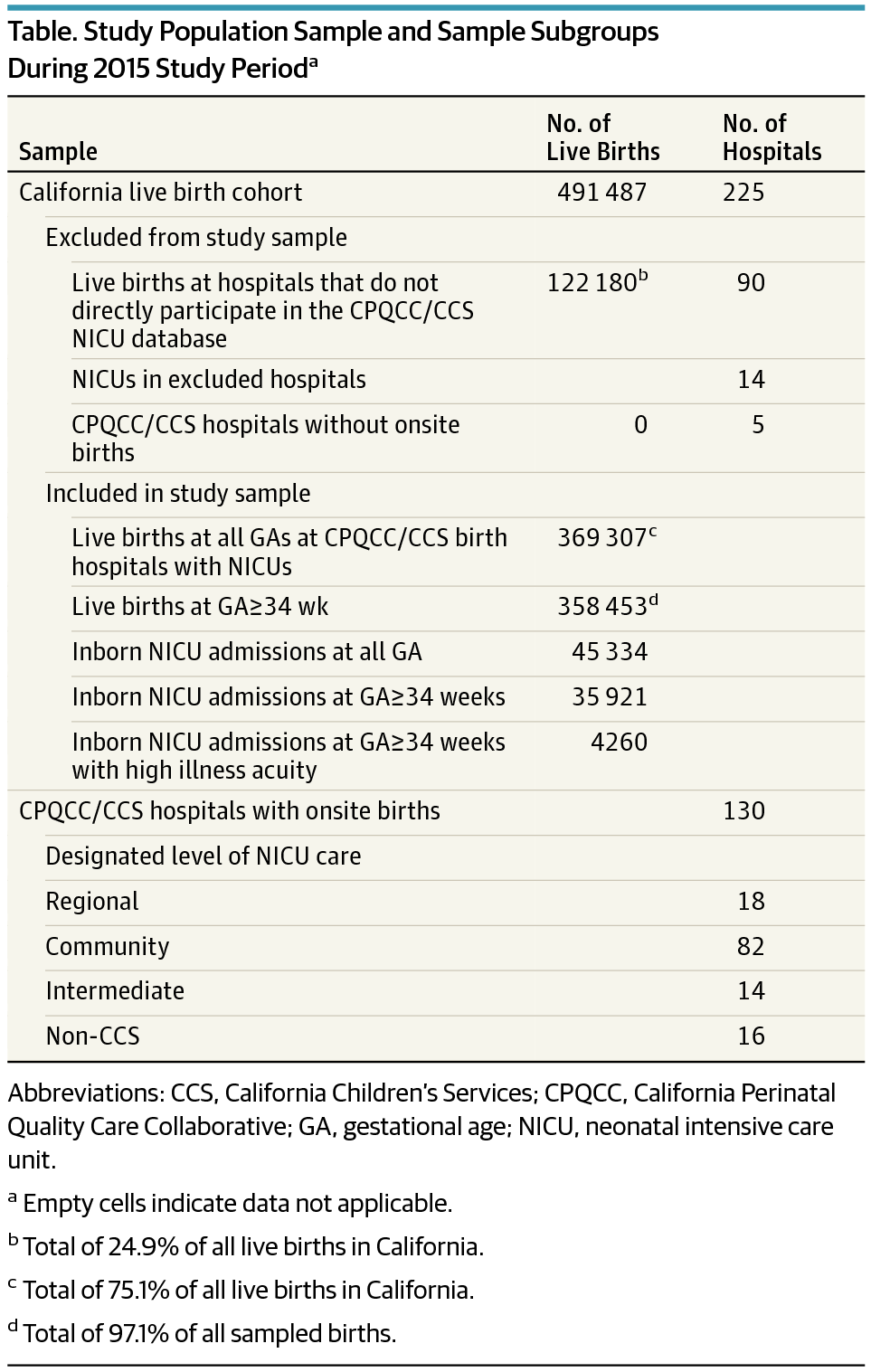当前位置:
X-MOL 学术
›
JAMA Pediatr.
›
论文详情
Our official English website, www.x-mol.net, welcomes your
feedback! (Note: you will need to create a separate account there.)
Association Between Neonatal Intensive Care Unit Admission Rates and Illness Acuity
JAMA Pediatrics ( IF 24.7 ) Pub Date : 2018-01-01 , DOI: 10.1001/jamapediatrics.2017.3913 Joseph Schulman 1 , David Braun 2 , Henry C. Lee 3, 4, 5 , Jochen Profit 3, 4, 5 , Grace Duenas 3, 4, 5 , Mihoko V. Bennett 3, 4, 5 , Robert J. Dimand 1 , Maria Jocson 1 , Jeffrey B. Gould 3, 4, 5
JAMA Pediatrics ( IF 24.7 ) Pub Date : 2018-01-01 , DOI: 10.1001/jamapediatrics.2017.3913 Joseph Schulman 1 , David Braun 2 , Henry C. Lee 3, 4, 5 , Jochen Profit 3, 4, 5 , Grace Duenas 3, 4, 5 , Mihoko V. Bennett 3, 4, 5 , Robert J. Dimand 1 , Maria Jocson 1 , Jeffrey B. Gould 3, 4, 5
Affiliation

|
Importance Most neonates admitted to a neonatal intensive care unit (NICU) are born at gestational age (GA) of 34 weeks or more. The degree of uniformity of admission criteria for these infants is unclear, particularly at the low-acuity end of the range of conditions warranting admission. Objectives To describe variation in NICU admission rates for neonates born at GA of 34 weeks or more and examine whether such variation is associated with high illness acuity or designated facility level of care. Design, Setting, and Participants Cross-sectional study of 35 921 NICU inborn admissions of GA at 34 weeks or more during calendar year 2015, using a population database of inborn NICU admissions at 130 of the 149 hospitals in California with a NICU. The aggregate service population comprised 358 453 live births. The individual NICU was the unit of observation and analysis. The analysis was stratified by designated facility level of care and correlations with the percentage admissions with high illness acuity were explored. The hypothesis at the outset of the study was that inborn admission rates would correlate positively with the percentage of admissions with high illness acuity. Exposures Live birth at GA of 34 weeks or more. Main Outcomes and Measures Inborn NICU admission rate. Results Of the total of 358 453 live births at GA of 34 weeks or more, 35 921 infants were admitted to a NICU and accounted for 79.2% of all inborn NICU admissions; 4260 (11.9%) of these admissions met high illness acuity criteria. Inborn admission rates varied 34-fold, from 1.1% to 37.7% of births (median, 9.7%; mean [SD], 10.6% [5.8%]). Percentage with high illness acuity varied 40-fold, from 2.4% to 95% (median, 11.3%; mean, 13.2% [9.9%]). Inborn admission rate correlated inversely with percentage of admissions with high illness acuity (Spearman &rgr; = −0.3034, P < .001). Among regional NICUs capable of caring for patients with the highest degree of illness and support needs, inborn admission rate did not significantly correlate with percentage of admissions with high illness acuity (Spearman &rgr; = −0.21, P = .41). Conclusions and Relevance Percentage of admissions with high illness acuity does not explain 34-fold variation in NICU inborn admission rates for neonates born at GA of 34 weeks or more. The findings are consistent with a supply-sensitive care component and invite future investigation to clarify the lower-acuity end of the range of conditions considered to warrant neonatal intensive care.
中文翻译:

新生儿重症监护病房入院率与疾病敏锐度的关系
重要性 入住新生儿重症监护病房 (NICU) 的大多数新生儿出生时的胎龄 (GA) 为 34 周或更长。这些婴儿入院标准的统一程度尚不清楚,特别是在需要入院的条件范围的低敏锐度端。目的 描述 GA 34 周或更长时间出生的新生儿的 NICU 入住率的变化,并检查这种变化是否与高疾病敏锐度或指定的设施护理水平有关。设计、设置和参与者 对 2015 日历年 34 周或更长时间 GA 的 35 921 例新生儿重症监护病房先天性入院的横断面研究,使用加利福尼亚州 149 家设有新生儿重症监护病房的医院中的 130 家医院先天性新生儿重症监护病房的人口数据库。总服务人口包括 358 453 名活产婴儿。单个 NICU 是观察和分析的单位。该分析按指定设施的护理水平进行分层,并探讨了与高疾病敏锐度入院率的相关性。研究开始时的假设是,先天性入院率与高疾病敏锐度入院率呈正相关。暴露 GA 时活产 34 周或更长时间。主要结果和措施 出生 NICU 入院率。结果 在 34 周或以上 GA 的 358 453 例活产中,35 921 名婴儿被收进 NICU,占所有出生 NICU 收治的 79.2%;其中 4260 人 (11.9%) 符合高疾病敏锐度标准。出生入院率变化了 34 倍,从出生的 1.1% 到 37.7%(中位数,9.7%;平均值 [SD],10.6% [5.8%])。高疾病敏锐度的百分比变化了 40 倍,从 2.4% 到 95%(中位数,11.3%;平均值,13.2% [9.9%])。先天入院率与高疾病敏锐度入院率呈负相关(Spearman &rgr; = -0.3034, P < .001)。在能够照顾具有最高疾病程度和支持需求的患者的区域 NICU 中,先天性入院率与高疾病敏锐度的入院率没有显着相关性 (Spearman &rgr; = -0.21, P = .41)。结论和相关性 对于 GA 34 周或更长时间出生的新生儿,具有高疾病敏锐度的入院率并不能解释 NICU 出生入院率的 34 倍差异。
更新日期:2018-01-01
中文翻译:

新生儿重症监护病房入院率与疾病敏锐度的关系
重要性 入住新生儿重症监护病房 (NICU) 的大多数新生儿出生时的胎龄 (GA) 为 34 周或更长。这些婴儿入院标准的统一程度尚不清楚,特别是在需要入院的条件范围的低敏锐度端。目的 描述 GA 34 周或更长时间出生的新生儿的 NICU 入住率的变化,并检查这种变化是否与高疾病敏锐度或指定的设施护理水平有关。设计、设置和参与者 对 2015 日历年 34 周或更长时间 GA 的 35 921 例新生儿重症监护病房先天性入院的横断面研究,使用加利福尼亚州 149 家设有新生儿重症监护病房的医院中的 130 家医院先天性新生儿重症监护病房的人口数据库。总服务人口包括 358 453 名活产婴儿。单个 NICU 是观察和分析的单位。该分析按指定设施的护理水平进行分层,并探讨了与高疾病敏锐度入院率的相关性。研究开始时的假设是,先天性入院率与高疾病敏锐度入院率呈正相关。暴露 GA 时活产 34 周或更长时间。主要结果和措施 出生 NICU 入院率。结果 在 34 周或以上 GA 的 358 453 例活产中,35 921 名婴儿被收进 NICU,占所有出生 NICU 收治的 79.2%;其中 4260 人 (11.9%) 符合高疾病敏锐度标准。出生入院率变化了 34 倍,从出生的 1.1% 到 37.7%(中位数,9.7%;平均值 [SD],10.6% [5.8%])。高疾病敏锐度的百分比变化了 40 倍,从 2.4% 到 95%(中位数,11.3%;平均值,13.2% [9.9%])。先天入院率与高疾病敏锐度入院率呈负相关(Spearman &rgr; = -0.3034, P < .001)。在能够照顾具有最高疾病程度和支持需求的患者的区域 NICU 中,先天性入院率与高疾病敏锐度的入院率没有显着相关性 (Spearman &rgr; = -0.21, P = .41)。结论和相关性 对于 GA 34 周或更长时间出生的新生儿,具有高疾病敏锐度的入院率并不能解释 NICU 出生入院率的 34 倍差异。











































 京公网安备 11010802027423号
京公网安备 11010802027423号